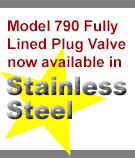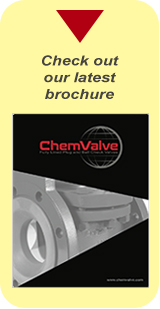Model 790 Throttling Control Valves
 ChemValve has designed a throttling control valve that will meet your control needs in the plant. You will get all the benefits of our fully lined plug valve model 790EB. ChemValve uses a V-Port style “characterized” seat. These V-Port seats are designed with the “V” opening to fit your specific application. That means, if you have a required Cv of 60, we will provide a V-Port Style seat with a maximum calculated Cv as close to 60 as possible. In most cases, your “span of control” will be significantly increased. We recommend a “special” coupling to eliminate the “lost motion (hysteresis)” between the valve stem and the coupling and between the coupling and the output drive of the actuator. Again, a significant source of “hysteresis” is eliminated and much tighter control is possible. ChemValve can supply this coupling if needed.
ChemValve has designed a throttling control valve that will meet your control needs in the plant. You will get all the benefits of our fully lined plug valve model 790EB. ChemValve uses a V-Port style “characterized” seat. These V-Port seats are designed with the “V” opening to fit your specific application. That means, if you have a required Cv of 60, we will provide a V-Port Style seat with a maximum calculated Cv as close to 60 as possible. In most cases, your “span of control” will be significantly increased. We recommend a “special” coupling to eliminate the “lost motion (hysteresis)” between the valve stem and the coupling and between the coupling and the output drive of the actuator. Again, a significant source of “hysteresis” is eliminated and much tighter control is possible. ChemValve can supply this coupling if needed.
ChemValve now suggests significantly “over sizing” the pneumatic actuator. You should take our “break torques” and multiply by 2.5 to arrive at the minimum actuator torque output at any point in the travel of the actuator. The over sized pneumatic actuator will be much “stiffer” then a pneumatic actuator sized on the conventional safety factors of 1.25 or 1.5. This will result in much tighter control around any given set point when the valve is in automatic control mode.
We recommend that a special cam be furnished for a standard type positioner or special programming for a digital type positioner. This will allow the “zero point” to be suppressed to account for the “no flow travel angle” from the closed position to the point where some flow area is being exposed as the plug travels toward the open position.
Virtually all quarter turn valves have a “no flow travel angle” that is created by the thickness of the sealing surfaces (seats - if the valve has them) as the inside edge of the hole through the plug or ball travels from the fully closed position to the point where that inside edge is just beginning to expose some flow area. The amount of this “no flow travel angle” varies with both the size of the valve and the design of the plug or ball and the sealing surfaces. If the “zero point” of the positioner input signal is not suppressed, the result will be a significant reduction in the real span of the control of the valve. For example, if the “no flow travel angle” of a valve is 30 degrees, then a standard positioner, without the special zero suppress feature, would actually control not from 4 to 20 ma, but from 9.33 to 20 ma. This can cause “PID wind-up” with controllers in the control loop.
ChemValve has a chart that lists the “dead angle” of the v-port seats by the valve size. The “dead angle” is the amount of rotation , in degrees, of the plug, starting with the full closed position, that is required before any flow area of the v-port seat starts to be uncovered by the inside edge of the hole through the plug. This chart is under Application Solutions.



